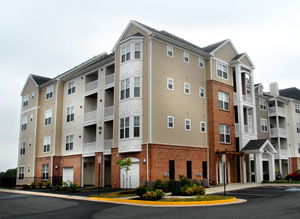
Multi-Agency Effort Supports Affordable Rental Housing

Riverside Station Apartments in Woodbridge, VA.
For owners, developers, tenants, and local communities working to create and preserve affordable housing, federal funding often makes up a significant share of a property’s financing structure. However, when funding comes from multiple sources (as it often does), owners and developers sometimes face overlapping or duplicative administrative requirements. Chief among these are the multiple property inspections that have traditionally been required when funding comes from two or more agencies, and “subsidy layering reviews,” which ensure that the total funding provided by various public sources does not exceed eligible project costs. While time-consuming, a single review is necessary to ensure compliance with the law; it’s just part of the cost of doing business. Multiple reviews on the other hand, are burdensome, costing both housing providers and the funding entities valuable staff time and resources. Fortunately, a group of like-minded federal and state agencies have gotten together around a shared goal of bureaucracy busting; specifically, the elimination of redundant, costly, and time-consuming administrative processes that come into play when funding affordable rental housing.
The idea originated in 2010 when the White House’s Domestic Policy Council formed an interagency Rental Policy Working Group. The Working Group includes key staff from the Departments of Treasury, Agriculture, and Housing and Urban Development. Each of these Cabinet-level agencies provides funding that supports affordable rental housing, and each has a stake in ensuring that the taxpayers’ money is well spent. To eliminate redundancies and streamline administrative processes, the Working Group has been tasked with engaging state, local, individual, and private stakeholders to help identify ways of reducing time and cost burdens, while still allowing the agencies to effectively “mind the store” when it comes to compliance monitoring. As you might imagine, the process has required a lot of interagency cooperation — getting everyone to agree to accept a common set of inspection and review criteria, for example, so that the work would only have to be performed once, and to everyone’s satisfaction.
With Memoranda of Understanding drawn up and in place among the participating federal agencies and a number of geographically disparate states, pilot programs were initiated that would put the Working Group’s bureaucracy busting theories into practice. One pilot was designed to eliminate unnecessary physical inspections at rental housing projects subsidized by more than one housing agency, thereby saving scarce local, state, and federal resources while reducing the burden on affordable housing providers and low-income tenants. Participating states selected to test the new streamlined inspection procedures and practices include Wisconsin, Michigan, Oregon, Washington, Minnesota, and Ohio. For the Subsidy Layering Review pilot, Michigan, Nevada, Ohio, Pennsylvania, South Carolina, and Wisconsin are taking part. These pilots are now underway, testing and refining coordinated strategies for intergovernmental monitoring and compliance. Eight other time- and cost-saving strategies — mostly centering on administrative streamlining at the federal level — have been recommended by the Rental Policy Working Group. In most cases, implementation (achieved through cooperation among the participating agencies) has been underway since last summer.
HUD’s Office of Policy Development and Research has a dedicated webpage to provide more information on this initiative: >Aligning Affordable Rental Housing Policy and Compliance at the State and Local Level. The webpage also has a link to the Rental Policy Working Group report: Federal Rental Alignment — Administrative Proposals.
With early indications pointing toward success, the hope is that these pilots will eventually be taken to scale, allowing federal, state, local, and private partners to realize significant time and cost savings. By reducing the regulatory burden and eliminating delays in the funding stream, low- and moderate-income families will benefit from increased access to affordable rental housing at a time when it’s needed most.
PD&R Leadership Message Archive
International & Philanthropic Spotlight Archive
Spotlight on PD&R Data Archive
Publications
Collecting, Analyzing, and Publicizing Data on Housing Turnover
Resilience Planning: What Communities Can Do to Keep Hazards from Turning into Disasters
Cityscape: Volume 26, Number 3
Case Studies
Case Study: Former School in Charleston, South Carolina, Transformed into Affordable Housing for Seniors
Case Study: Avalon Villas Combines Affordable Housing and Services for Families in a Gentrifying Phoenix Neighborhood

The contents of this article are the views of the author(s) and do not necessarily reflect the views or policies of the U.S. Department of Housing and Urban Development or the U.S. Government.
Note: Guidance documents, except when based on statutory or regulatory authority or law, do not have the force and effect of law and are not meant to bind the public in any way. Guidance documents are intended only to provide clarity to the public regarding existing requirements under the law or agency policies.



